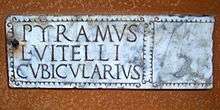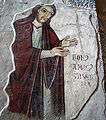Titulus (inscription)
Titulus (Latin "inscription" or "label", the plural tituli is also used in English) is a term used for the labels or captions naming figures or subjects in art, which were commonly added in classical and medieval art, and remain conventional in Eastern Orthodox icons. In particular the term describes the conventional inscriptions on stone that listed the honours of an individual[1] or that identified boundaries in the Roman Empire. A Titulus pictus is a merchant's mark or other commercial inscription.

- See also Titulus (Roman Catholic) for Roman churches called tituli, or titulus (disambiguation) for more meanings.
The sense of "title", as in "book title", in modern English derives from this artistic sense, just as the legal sense derives from plainer inscriptions of record.[2]
The most famous titulus was "IESVS NAZARENVS REX IVDAEORVM" - Jesus the Nazarene the King of the Judeans - inscribed on the placard hanging above Jesus' head on the Cross.
Use in Western art
The increasing reluctance of the art of the West to use tituli was perhaps because so few people could read them in the Early Medieval period, and later because they reduced the illusionism of the image. Instead a system of attributes, objects identifying popular saints, was developed, but many such figures in Western art are now unidentifiable. This reluctance affected the choice of scenes shown in art; only those miracles of Jesus that were easily identifiable visually tended to be shown in cycles of the Life of Christ. Thus the Raising of Lazarus and Wedding at Cana are by far the most commonly shown miracles, and the healing miracles, visually easy to confuse, are neglected.[3][4] The problems can clearly be seen in the small scenes of the Saint Augustine Gospels (late 6th century), where about 200 years after the manuscript was written tituli were added, which according to some art historians misidentify some scenes.[5] Banderoles were a solution that became popular in the later Middle Ages, and in Northern Europe in the 15th century were sometimes used very extensively for speech, rather as in modern comics, as well as tituli. These were abandoned as old-fashioned in the Renaissance, but increased respect for classical traditions led to continued use of Ancient Roman-style tituli where they were considered necessary, including on portraits.
Examples of tituli
- In the context of the Crucifixion, the titulus "IESVS NAZARENVS REX IVDAEORVM" (and its translations in Aramaic and Greek[6]) is believed to have been affixed to Jesus' cross. INRI is the abbreviation for the above-mentioned Latin translation. See INRI and Titulus Crucis.
- At the recovery of the coffin of King Arthur at Glastonbury Abbey, at an opportune moment after a devastating fire in the 12th century, a lead cross of Arthur was alleged to have borne the explicit titulus "HIC JACET SEPULTUS INCLITUS REX ARTHURUS IN INSULA AVALONIA". The well-publicized discovery described by Giraldus Cambrensis, redoubled the pilgrimages to the Abbey.
Gallery
 14th-century Italian titulus records the identity of Bonamico Taverna, known only from this donor portrait
14th-century Italian titulus records the identity of Bonamico Taverna, known only from this donor portrait.jpg) The 11th-century Bayeux Tapestry makes extensive use of tituli to explain the complicated story: "HIC RESIDET HAROLD REX ANGLORUM" and "STIGANT ARCHIEPS".
The 11th-century Bayeux Tapestry makes extensive use of tituli to explain the complicated story: "HIC RESIDET HAROLD REX ANGLORUM" and "STIGANT ARCHIEPS". Two "Saint Theodore"s are distinguished by tituli in the Byzantine Harbaville Triptych
Two "Saint Theodore"s are distinguished by tituli in the Byzantine Harbaville Triptych Extensive tituli, and "speech-bubbles" on banderoles in this early 16th-century tapestry
Extensive tituli, and "speech-bubbles" on banderoles in this early 16th-century tapestry
Notes
- Smith, William (1875). "Nobiles". Dictionary of Greek and Roman Antiquities. London. Reprinted by The University of Chicago.
- "Title", Oxford English Dictionary.
- Schiller, I, 152–3
- Mâle, 177
- Lewine, Carol F.; JSTOR Vulpes Fossa Habent or the Miracle of the Bent Woman in the Gospels of St. Augustine, Corpus Christi College, Cambridge,
- John 19:20
References
- Emile Mâle, The Gothic Image: Religious Art in France of the Thirteenth Century, p 165–8, English trans of 3rd edn, 1913, Collins, London (and many other editions), ISBN 978-0064300322
- Schiller, Gertud, Iconography of Christian Art, Vol. I, 1971 (English trans from German), Lund Humphries, London, ISBN 0-85331-270-2
![]()
